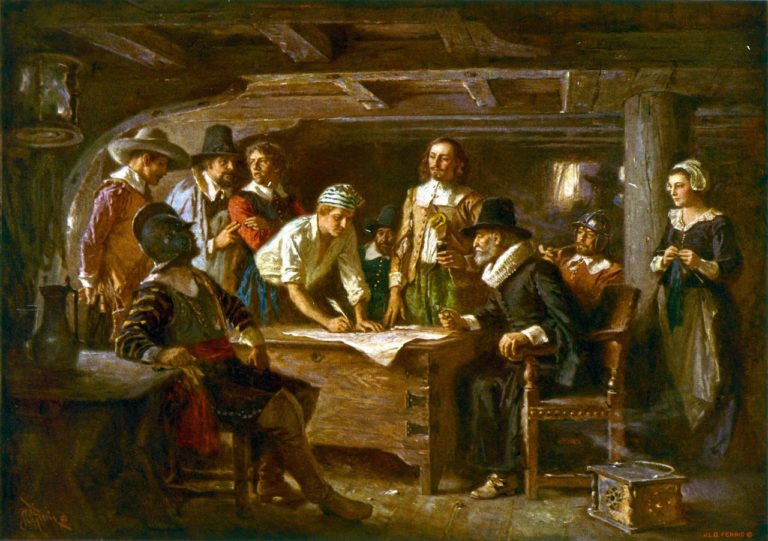February 8th- The Dawes Act of 1887 was Passed- It Divided Up Indian Land
The Dawes Act of 1887 (also known as the General Allotment Act or the Dawes Severalty Act of 1887), adopted by Congress in 1887, authorized the President of the United States to survey American Indian tribal land and divide it into allotments for individual Indians. Those who accepted allotments and lived separately from the tribe would be granted United States citizenship. The Dawes Act was amended in 1891, in 1898 by the Curtis Act, and again in 1906 by the Burke Act.
The Act was named for its creator, Senator Henry Laurens Dawes of Massachusetts. The objectives of the Dawes Act were to lift the Native Americans out of poverty and to stimulate assimilation of them into mainstream American society. Individual household ownership of land and subsistence farming on the European-American model was seen as an essential step. The act also provided what the government would classify as “excess” those Indian reservation lands remaining after allotments, and sell those lands on the open market, allowing purchase and settlement by non-Native Americans.
The Dawes Commission, set up under an Indian Office appropriation bill in 1893, was created to try to persuade the Five Civilized Tribes to agree to allotment plans. (They had been excluded from the Dawes Act by their treaties.) This commission registered the members of the Five Civilized Tribes on what became known as the Dawes Rolls.
The Curtis Act of 1898 amended the Dawes Act to extend its provisions to the Five Civilized Tribes; it required abolition of their governments, allotment of communal lands to people registered as tribal members, and sale of lands declared surplus, as well as dissolving tribal courts. This completed the extinguishment of tribal land titles in Indian Territory, preparing it to be admitted to the Union as the state of Oklahoma.
90 Million Acres Taken Away and Sold
During the ensuing decades, the Five Civilized Tribes lost 90 million acres of former communal lands, which were sold to non-Natives. In addition, many individuals, unfamiliar with land ownership, the target of speculators and criminals, and stuck with allotments that were too small for profitable farming, lost their household lands. Tribe members also suffered from the breakdown of the social structure of the tribes.
During the Great Depression, the Franklin D. Roosevelt administration supported passage on June 18, 1934 of the US Indian Reorganization Act (also known as the Wheeler-Howard Law). It ended land allotment and created a “New Deal” for Indians, renewing their rights to reorganize and form their self-governments.
The Indian Problem
During the 1850s, the United States federal government’s attempt to exert control over the Native Americans expanded. Numerous new European immigrants were settling on the eastern border of the Indian territories, where most of the Native Americans tribes were situated. Conflicts between the groups increased as they competed for resources and operated according to different cultural systems. Many European Americans did not believe that members of the two racial societies could coexist within the same communities. Searching for a quick solution to their problem, William Medill the Commissioner of Indian Affairs, proposed establishing “colonies” or “reservations” that would be exclusively for the natives, similar to those which some native tribes had created for themselves in the east. It was a form of removal whereby the US government would uproot the natives from their current locations to positions to areas in the region beyond the Mississippi River; this would enable settlement by European Americans in the Southeast in turn opening up new placement for the new white settlers and at the same time protecting them from the corrupt “evil” ways of the subordinate natives.
The new policy intended to concentrate Native Americans in areas away from encroaching settlers, but it caused considerable suffering and many deaths. During the nineteenth century, Native American tribes resisted the imposition of the reservation system and engaged with the United States Army in what were called the Indian Wars in the West for decades. Finally defeated by the US military force and continuing waves of encroaching settlers, the tribes negotiated agreements to resettle on reservations. Native Americans ended up with a total of over 155 million acres (630,000 km2) of land, ranging from arid deserts to prime agricultural land.
Put Them on a Reservation
The Reservation system, though forced upon Native Americans, was a system that allotted each tribe a claim to their new lands, protection over their territories, and the right to govern themselves. With the Senate supposedly being able to intervene only through the negotiation of treaties, they adjusted their ways of life and tried to continue their traditions. The traditional tribal organization, a defining characteristic of Native Americans as a social unit, became apparent to the non-native communities of the United States and created a mixed stir of emotions. The tribe was viewed as a highly cohesive group, led by a hereditary, chosen chief, who exercised power and influence among the members of the tribe by aging traditions. The tribes were seen as strong, tight-knit societies led by powerful men who were opposed to any change that weakened their positions. Many white Americans feared them and sought reformation. The Indians’ failure to adopt the “Euroamerican” lifestyle, which was the social norm in the United States at the time, was seen as both unacceptable and uncivilized.
By the end of the 1880s, a general consensus seem to have been reached among many US stakeholders that the assimilation of Native Americans into white American culture was top priority; it was the time for them to leave behind their tribal landholding, reservations, traditions and ultimately their Indian identities.
On February 8, 1887, the Dawes Allotment Act was signed into law by President Grover Cleveland.
Responsible for enacting the division of the American native reserves into plots of land for individual households, the Dawes Act was created by reformers to achieve six goals:
breaking up of tribes as a social unit,
encouraging individual initiatives,
furthering the progress of native farmers,
reducing the cost of native administration,
securing parts of the reservations as Indian land, and
opening the remainder of the land to white settlers for profit
The compulsory Act forced natives to succumb to their inevitable fate; they would undergo severe attempts to become “Euro-Americanized” as the government allotted their reservations with or without their consent. Native Americans held very specific ideologies pertaining to their land, to them the land and earth were things to be valued and cared for, for they represented all things that produced and sustained life, it embodied their existence and identity, and created an environment of belonging. In opposition to their white counterparts, they did not see it from an economic standpoint.
But, many natives began to believe they had to adapt to the majority culture in order to survive. They would have to embrace these beliefs and surrender to the forces of progress. They were to adopt the values of the dominant society and see land as real estate to be bought and developed; they were to learn how to use their land effectively in order to become prosperous farmers.[13] As they were inducted as citizens of the country, they would shed their uncivilized discourses and ideologies, and exchange them for ones that allowed them to become industrious self-supporting citizens, and finally rid themselves of their “need” for government supervision.
Provisions of the Dawes Act
The important provisions of the Dawes Act were:
A head of family would receive a grant of 160 acres (0.65 km2), a single person or orphan over 18 years of age would receive a grant of 80 acres (320,000 m2), and persons under the age of 18 would receive 40 acres (160,000 m2) each;
the allotments would be held in trust by the U.S. Government for 25 years;
Eligible Indians had four years to select their land; afterward the selection would be made for them by the Secretary of the Interior.
Every member of the bands or tribes receiving a land allotment is subject to laws of the state or territory in which they reside. Every Indian who receives a land allotment “and has adopted the habits of civilized life” (lived separate and apart from the tribe) is bestowed with United States citizenship “without in any manner impairing or otherwise affecting the right of any such Indian to tribal or other property.”
The Secretary of Interior could issue rules to assure equal distribution of water for irrigation among the tribes, and provided that “no other appropriation or grant of water by any riparian proprietor shall be authorized or permitted to the damage of any other riparian proprietor.”
The Dawes Act did not apply to the territory of the:
Cherokee, Creek, Choctaw, Chickasaw, Seminole, Miami and Peoria in Indian Territory
Osage, Sac and Fox, in the Oklahoma Territory
any of the reservations of the Seneca Nation of New York, or
a strip of territory in the State of Nebraska adjoining the Sioux Nation
Provisions were later extended to the Wea, Peoria, Kaskaskia, Piankeshaw, and Western Miami tribes by act of 1889.[19] Allotment of the lands of these tribes was mandated by the Act of 1891, which amplified the provisions of the Dawes Act


